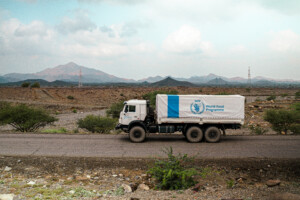OCHA Sudan bulletin 40: Inter-communal violence displaced 320 families in North Darfur
About 320 families have been displaced from 13 villages and farms near Kosa in Tawila locality owing to clashes between farmers and pastoralists early September. The Sudanese Commission of Refugees estimated that about 100,000 Syrians have taken refuge in the country. According to FEWS NET, food security in the country is likely to improve starting from October.
About 320 families have been displaced from 13 villages and farms near Kosa in Tawila locality owing to clashes between farmers and pastoralists early September. The Sudanese Commission of Refugees estimated that about 100,000 Syrians have taken refuge in the country. According to FEWS NET, food security in the country is likely to improve starting from October.
The UN Office for the Coordination of Humanitarian Affairs (OCHA) reported in its latest weekly bulletin that an inter-agency mission led by the Sudanese Humanitarian Aid Commission (HAC) and OCHA visited the area of Kosa in North Darfur’s Tawila locality in late September to assess the humanitarian needs of newly displaced who sought protection in the area from inter-communal clashes.
The visit came in response of reports by local authorities of the displacement of some 7,000 people from the Kosa area to Katur village. Community leaders reported an estimated 320 families or roughly 1,600 individuals who had been displaced from 13 villages and farms near Kosa.
The team observed that the people who had been displaced following inter-communal violence between farmers and pastoralists in early September had dispersed in the area. The community leaders said that people are taking shelter in the surrounding hills because they fear further attacks.
The inter-agency team consisting of a number of UN agencies, the Sudanese Red Crescent Society (SRCS) and line ministries was unable to access the people taking shelter in the hills owing to inaccessibility, as the terrain is rocky and there are no roads. The team concluded that people in Katur area, both residents and newly displaced, are in need of emergency assistance.
About 100,000 Syrian refugees in Sudan
Estimates from the Sudanese Commission of Refugees (COR) indicate that since 2011 Sudan has received a considerable number of Syrian refugees, with the number of arrivals estimated at 100,000 people.
The current policy of the Sudanese government is to receive all Syrian nationals coming to the country with no visa required for entry. Syrians are granted access to state health and education services.
The majority of new arrivals have settled in the wider Khartoum area and have become integrated into urban host communities, including an older pre-existing Syrian community, the OCHA bulletin reads.
Joint UN Refugee Agency (UNHCR) and COR registration of Syrians at the Refugee Counselling Services (RCS) Centre resumed on 8 November 2015, with 5,515 Syrian refugees being registered by the end of August 2016.
Food security likely to improve
 In its most recent key messages on food security in Sudan, FEWS NET said that average to above-average rainfall, which is anticipated throughout October, is likely to lead to favourable cropping and pasture prospects that should improve food security outcomes with harvests starting in October/November.
In its most recent key messages on food security in Sudan, FEWS NET said that average to above-average rainfall, which is anticipated throughout October, is likely to lead to favourable cropping and pasture prospects that should improve food security outcomes with harvests starting in October/November.
The number of people facing Crisis-Integrated Food Security Phase Classification (IPC) Phase 3 or worse acute food insecurity levels will likely decrease significantly in the post-harvest period. Such levels of food insecurity mainly affect conflict-affected people and/or displaced people in South Kordofan and Blue Nile states, and the Darfur region.
Heavy rains and flooding since June have damaged infrastructure and houses, destroyed crops, and delayed planting and weeding in localised areas throughout Sudan.
Staple food prices showed mixed trends for the different markets between July and August. Staple food prices are likely to begin declining seasonally in most markets with the onset of harvests in October/November, FEWS NET said.











 and then
and then